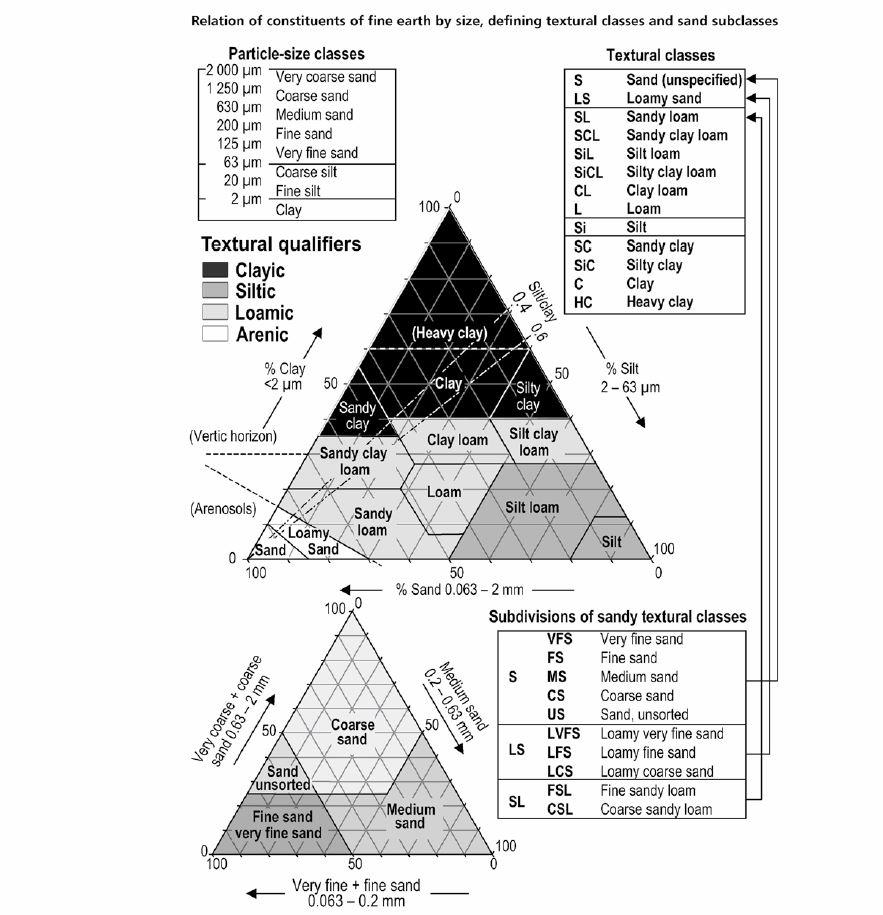4 - Soils
a
A horizon
The mineral horizon at or near the surface in which an accumulation of humified organic matter is mixed with the mineral material. Also, any ploughed or disturbed surface layer.
Aggregates
Soil aggregates are soil peds of a range of sizes (microaggregates 53-250μm and macroaggregates >250μm (usually taken as 250-2000μm)). Definitions and size classes can be found in Six et al. (2004).
Aggregation
Process whereby primary soil particles (sand, silt, clay) are bound together, usually by natural forces and substances derived from root exudates and microbial activity. Soil aggregates are arranged to form soil peds, units of soil structure, classified by shape, size or grade. Definitions and size classes can be found in Six et al. (2004).
Aspect
Compass orientation of a slope.
b
B horizon
Mineral horizon below an O, A, or E horizon. The B horizon show evidences of soil forming processes which distinguish it from the parent material of soil (underlying C horizon). The distinctive characteristics can be: (1) accumulation (iluviation) of clay, sesquioxides, humus, or a combination of these; (2) granular, prismatic, or blocky structure; (3) redder or browner colours than those in the A horizon; (4) evidences of accumulation of secondary gypsum or carbonates; or (5) a combination of these.
Base saturation
The degree to which a soil having cation-exchange properties is saturated with exchangeable bases (sum of Ca, Mg, Na, K), expressed as a percentage of the total cation-exchange capacity.
Bedrock
The solid rock that underlies the soil and other unconsolidated material or that is exposed at the surface.
Bulk density
The dry mass of soil per unit bulk volume of soil, expressed as g/cm3, usually given on an oven-dry (110° C) basis.
c
C horizon
Mineral horizon or layer, excluding indurated bedrock, that is little affected by soil-forming processes and does not have the properties typical of the overlying horizon. The material of a C horizon may be either like or unlike that in which the solum formed. If the material is known to differ from that in the solum, an Arabic numeral, commonly a 2, precedes the letter C.
Cation exchange capacity (CEC)
The total amount of exchangeable cations that can be held by the soil, expressed in terms of cmol of charge per kg of soil at neutrality (pH 7.0) or at some other stated pH value.
Clay
Soil particles less than 0.002 mm in diameter OR a soil textural class with 40% or more clay, less than 45% sand, and less than 40% silt.
d
Diagnostic horizon
Horizontal soil layers characterized by a combination of attributes that reflect widespread, common results of the processes of soil formation (Bridges, 1997) or indicates specific conditions of soil formation (WRB, 2006).
e
E horizon
Albic horizon, which is an eluvial horizon with evidences of losing soil components; it is usually a light-coloured subsurface horizon from which clay and free iron and aluminium have been removed to the extent that the colour of the horizon is determined by the colour of the sand and silt particles rather than by coatings on these particles.
Electrical Conductivity (EC)
Measure of a material’s ability to accommodate the transport of an electric charge and used as a measure of the salinity of the soil, and to estimate practical consequences for crops. EC of a soil suspension at a given soil to water ratio (usually 1:5 or saturated extract as a proxy to soil solution), expressed as Siemen per m.
Exposure
Compass orientation of a slope.
h
Horizon
One of the layers that form in the soil profile as a result of soil-forming processes. A horizon can appear as a defined visible layer.
Humus
The well decomposed, amorphous, stable fraction of the organic matter in mineral soils with a low specific weight and high surface area; usually composed of many organic compounds of high molecular weight and dark colour.
o
O horizon
A surface horizon, or a subsurface horizon occurring at any depth if it has been buried, that consists of poorly aerated organic material. It is usually undecomposed or partially decomposed organic matter (litter such as leaves, needles, twigs, moss, and lichens) (WRB, 2006). Often referred as the histic horizon (from Greek histos, tissue).
Organic Matter
Plant and animal residue in the soil in various stages of decomposition.
p
Parent material
The solid or unconsolidated mineral material in or on which soil forms.
Ped
An individual natural soil aggregate, in contrast to a clod caused by disturbance, or a concretion caused by cementation. Described as a range of shapes: platy (laminated), prismatic (vertical axis of aggregates longer than horizontal), columnar (prisms with rounded tops), blocky (angular or subangular) and granular.
Pedon
The smallest volume that can be called “a soil.” A pedon is three dimensional and large enough to permit study of all horizons. Its area ranges from about 1 to 10 m2, depending on the variability of the soil.
pH
Measure of acidity, measured from 1 (acid) through 7 (neutral) to 14 (alkaline) expressed on a logarithmic scale. Most soils have a pH 3 to 9.
Pores
The space in-between particles or aggregates of soil that can become filled with air or water.
Porosity
Volume of water and air that can be held in a soil; ratio of the volume of voids to the total volume of the soil.
Profile
A column of soil extending through all its horizons and into the parent material and large enough to be used to characterise the soil condition at a particular place.
r
R horizon
Hard, consolidated bedrock beneath the soil. The bedrock commonly underlies a C horizon but can be directly below an A or a B horizon.
Relief
The elevations or inequalities of a land surface, considered collectively.
s
Sand
Soil particles being 0.06 (0.051) -2.0 mm in diameter OR a soil textural class with 65% or more sand and less than 8% clay.
Silt
Soil particles being 0.002-0.06 (0.051) mm.
Slope
The inclination of the land surface from the horizontal. Percentage of slope is the vertical distance divided by horizontal distance, multiplied by 100. Thus, a slope of 20 percent is a drop of 20 m in 100 m of horizontal distance.
Soil
A combination of four constituents: mineral material (sand, silt, clay and rock particles), organic material, air and water, forming a natural, three-dimensional body at the earth’s surface. It is capable of supporting plant growth and has properties resulting from the integrated effect of climate and living matter acting on parent material, as conditioned by relief over periods of time.
Soil depth
Depth of soil profile from the top to parent material or bedrock or to the layer below root penetration is not (or no longer) possible. It differs significantly for different soil types. It is one of basic criterions used in soil classification. Soils can be very shallow (less than 25 cm), shallow (25 cm-50 cm), moderately deep (50 cm-90 cm), deep (90cm-150 cm) and very deep (more than 150 cm).
Soil fertility
The ability of the soil to supply essential plant nutrients and soil water in adequate amounts and proportions for plant growth and reproduction in the absence of toxic substances which may inhibit plant growth.
Solum
Topsoil and subsoil layers that have undergone the same soil forming conditions. The base of the solum (plural, sola) is the relatively unweathered parent material. Solum and soils are not synonymous. Some soils include layers that are not affected by soil formation.
Specific Heat Capacity
The amount of heat which is required in order to increase its temperature. Measured in ‘joules per kilogram per kelvin degree’, or J/kg/oK , it is specifically the amount of heat energy in joules needed to increase the temperature of one kilogram of the substance by one Kelvin degree.
Stones
Soil particles more than 2 mm in diameter.
Structure
The aggregation of primary soil particles into units separated from each other by surfaces of weakness, ‘architecture’ of soil – how it is constructed and made up.
Subsoil
Technically, soil horizons below plough depth; usually B horizons.
t
Texture
The relative proportions of sand, silt, and clay particles in a mass of soil. Texture can be coarse (sand particles predominate), medium (equal parts of sand, silt and clay), or fine (clay particles predominate). The basic textural classes, in order of increasing proportion of fine particles, are; sand, loamy sand, sandy loam, loam, silt loam, silt, sandy clay loam, clay loam, silty clay loam, sandy clay, silty clay, and clay. The sand, loamy sand, and sandy loam classes may be further divided by specifying “coarse,” “fine”, or “very fine’.
See texture triangle.
Texture triangle
Diagram allotting names to soils with specific portions of sand, silt and clay (http://www.fao.org/3/a-i3794e.pdf), consult Figure:

Topsoil
The surface soil horizon (A) which is modified when cultivated, and designated Ap.






